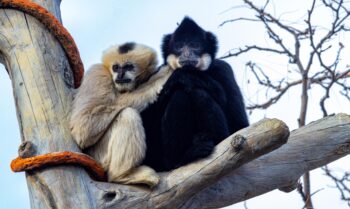May 14, 2020
Amphibians in Need
How Denver Zoo Conserves High-Altitude Endangered Amphibians, from Colorado to Peru
The world is undergoing a sixth mass extinction, and amphibians are particularly hard hit. Amphibians – frogs, toads, salamanders, newts, among others – are indicator species that signal ecosystem health because they are highly sensitive to changes in both aquatic and terrestrial environments. More than 40% of the world’s amphibian species are threatened with extinction, primarily from habitat degradation, overharvest, and invasive species. Denver Zoo is on the front lines fighting to reverse these declines, both on campus and in the field, from the Rocky Mountains to Peru’s Andes.
Denver Zoo has been working in Peru since 2007 to conserve the two largest completely aquatic frogs in the world: the Lake Titicaca frog (critically endangered) and Lake Junín frog (endangered). These amphibians are two of 63 species of Andean water frogs (genus Telmatobius), of which 85% are endangered. Adults of both species measure up to 6-7 inches in body length, and Junín tadpoles are truly huge reaching 7.8 inches long. Both frogs spend their entire life in the waters of high-altitude Andean lakes.
Lake Titicaca frogs are endemic to Lake Titicaca, a 12,500’ elevation lake located on border between Bolivia and Peru. Lake Titicaca is the world’s highest navigable lake, and it is facing a multitude of environmental threats including mining pollution, untreated sewage, and solid waste. Lake Titicaca frogs are very sensitive to pollutants, which they absorb through the large folds of skin that allow them to breathe underwater. Two exotic invasive species, the rainbow trout and kingfish, prey on tadpoles and frog eggs, and they compete with adult frogs for native fish that are adult frogs’ main source of food. Over-harvest is also a major threat, as many people consume Lake Titicaca frogs in juices and shakes believing the frogs to have medicinal properties.
The Lake Junín frog is endemic to the 13,400’ elevation Lake Junín watershed in central Peru, and is facing similar threats including pollution, exotic invasive species, and over-harvest. This region is known as Peru’s mining capital with some of the country’s most severe pollution, which local people frequently cite as causing harm to both their health and their environment. Communities living around the lake are mainly farmers making a living from growing crops and sheep. People use frogs as a protein source and report frogs to now be very difficult to find, but they still consume the few that are found.
In our own backyard, Denver Zoo is working to conserve boreal toads, a cold-adapted toad found from 8,000’-12,000’ elevation. The boreal toad is a state-listed endangered species in Colorado that has seen precipitous declines with the introduction of chytrid fungus. Chytrid fungus is driving amphibian extinctions across the globe, with boreal toads in Colorado the latest potential victim. Serious counter-measures are desperately needed.
How is Denver Zoo helping to conserve these endangered species? Whether at home or in Peru, we apply our considerable captive breeding skills and engage communities and institutions in our conservation work. In Peru we train and equip rangers in two National Reserves to monitor amphibians; we finance and mentor students of biology, veterinary medicine and other careers; we advise and finance a local zoo with education and captive breeding programs; support the Peruvian Government in developing Conservation Strategies for our two focal species; and provide assistance to the Binational Conservation Plan for Lake Titicaca frog Committee. In the Rocky Mountains, we have a captive breeding and reintroduction program for Utah boreal toads, which appear to have high chytrid resistance. Building on that success, we are now working to expand our work in Colorado. You can help us save boreal toads by reducing your water use at home, which leaves more water for wetland-dependent wildlife. Amphibians across the globe face a gauntlet of threats. At Denver Zoo, we believe the only way to reverse these trends is to combine world class animal care, cutting-edge field conservation, and innovative approaches to inspiring communities to save wildlife.
Subscribe
Be among the first to hear the latest animal updates, important stories and details about all the fun happening around Denver Zoo.
Tags
-
 April 15, 2024
April 15, 2024Good Luck, Chuck!
Good Luck, Chuck! Beloved Bachelor Relocating as Part of Asian Elephant Species Survival Plan In a heartfelt and collaborative…
-
 April 15, 2024
April 15, 2024African Impact
African Impact Two New African Field Conservation ProgramsAim to Protect Gorillas + Grey Crowned Cranes We're honored to provide…
-
 March 1, 2024
March 1, 2024Last Place(s) on Earth
Last Place(s) on Earth New Asian Field Conservation Programs Protect Asian Elephants, Sumatran Orangutans + more Indonesia's Leuser Ecosystem…

